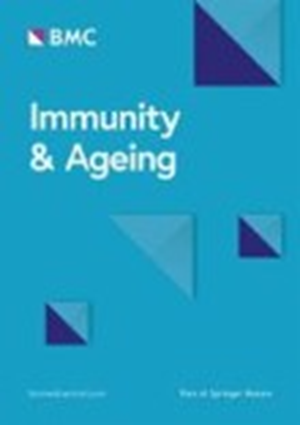Addition of inflammation-related biomarkers to the CAIDE model for risk prediction of all-cause dementia, Alzheimer’s disease and vascular dementia in a prospective study
IF 5.2
2区 医学
Q1 GERIATRICS & GERONTOLOGY
引用次数: 0
Abstract
It is of interest whether inflammatory biomarkers can improve dementia prediction models, such as the widely used Cardiovascular Risk Factors, Aging and Dementia (CAIDE) model. The Olink Target 96 Inflammation panel was assessed in a nested case-cohort design within a large, population-based German cohort study (n = 9940; age-range: 50–75 years). All study participants who developed dementia over 20 years of follow-up and had complete CAIDE variable data (n = 562, including 173 Alzheimer’s disease (AD) and 199 vascular dementia (VD) cases) as well as n = 1,356 controls were selected for measurements. 69 inflammation-related biomarkers were eligible for use. LASSO logistic regression and bootstrapping were utilized to select relevant biomarkers and determine areas under the curve (AUCs). The CAIDE model 2 (including Apolipoprotein E (APOE) ε4 carrier status) predicted all-cause dementia, AD, and VD better than CAIDE model 1 (without APOE ε4) with AUCs of 0.725, 0.752 and 0.707, respectively. Although 20, 7, and 4 inflammation-related biomarkers were selected by LASSO regression to improve CAIDE model 2, the AUCs did not increase markedly. CAIDE models 1 and 2 generally performed better in mid-life (50–64 years) than in late-life (65–75 years) sub-samples of our cohort, but again, inflammation-related biomarkers did not improve their predictive abilities. Despite a lack of improvement in dementia risk prediction, the selected inflammation-related biomarkers were significantly associated with dementia outcomes and may serve as a starting point to further elucidate the pathogenesis of dementia.在一项前瞻性研究中,将炎症相关生物标志物加入 CAIDE 模型,用于预测全因痴呆症、阿尔茨海默病和血管性痴呆症的风险
炎症生物标志物能否改善痴呆症预测模型,如广泛使用的心血管风险因素、衰老和痴呆症(CAIDE)模型,这一点很值得关注。在一项大型德国人群队列研究(n = 9940;年龄范围:50-75 岁)中,通过嵌套病例队列设计对 Olink Target 96 炎症面板进行了评估。所有在 20 年随访期间患上痴呆症且有完整 CAIDE 变量数据的研究参与者(n = 562,包括 173 例阿尔茨海默病(AD)和 199 例血管性痴呆(VD)病例)以及 n = 1,356 例对照者都被选中进行测量。69种炎症相关生物标记物符合使用条件。利用LASSO逻辑回归和引导法选择相关的生物标志物并确定曲线下面积(AUC)。CAIDE模型2(包括载脂蛋白E(APOE)ε4携带者状态)比CAIDE模型1(不包括APOEε4)更能预测全因痴呆、AD和VD,AUC分别为0.725、0.752和0.707。虽然通过 LASSO 回归选择了 20、7 和 4 个与炎症相关的生物标记物来改进 CAIDE 模型 2,但其 AUC 并没有显著增加。CAIDE模型1和2在中年(50-64岁)子样本中的表现普遍优于晚年(65-75岁)子样本,但炎症相关生物标志物同样没有提高其预测能力。尽管在痴呆症风险预测方面缺乏改进,但所选的炎症相关生物标志物与痴呆症结果有显著相关性,可作为进一步阐明痴呆症发病机制的起点。
本文章由计算机程序翻译,如有差异,请以英文原文为准。
求助全文
约1分钟内获得全文
求助全文
来源期刊

Immunity & Ageing
GERIATRICS & GERONTOLOGY-IMMUNOLOGY
CiteScore
10.20
自引率
3.80%
发文量
55
期刊介绍:
Immunity & Ageing is a specialist open access journal that was first published in 2004. The journal focuses on the impact of ageing on immune systems, the influence of aged immune systems on organismal well-being and longevity, age-associated diseases with immune etiology, and potential immune interventions to increase health span. All articles published in Immunity & Ageing are indexed in the following databases: Biological Abstracts, BIOSIS, CAS, Citebase, DOAJ, Embase, Google Scholar, Journal Citation Reports/Science Edition, OAIster, PubMed, PubMed Central, Science Citation Index Expanded, SCImago, Scopus, SOCOLAR, and Zetoc.
 求助内容:
求助内容: 应助结果提醒方式:
应助结果提醒方式:


